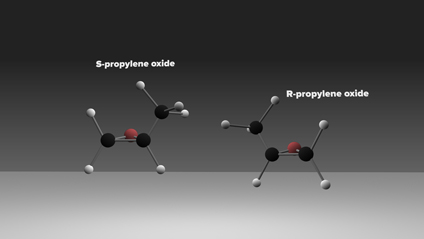First Chiral Molecule Discovered in Space
The discovery of a chiral molecule in space has the potential to sort out one of the biggest mysteries in the chemistry of life.

Like albuterol and other "handed" molecules, the first chiral molecule discovered in space, propylene oxide, comes in two forms: S (Latin for sinister, left) and R (Latin for rectus, right).
B. Saxton (NRAO / AUI / NSF)
B. Saxton (NRAO / AUI / NSF)
Despite college chemistry I never understood chirality’s relevance to life until (of all things) I was diagnosed with asthma. I received a prescription for albuterol, but it made me feel shaky and out of sorts. Turns out that albuterol is actually a mix of two “handed”, or chiral molecules, identical in chemical formula but very different in how they act on the body.
Like hands, the two versions of albuterol are mirror images of each other, with a hydrogen atom that sticks out like a sore thumb. “Right-handed” albuterol binds to receptors and dilates airways during an asthma attack. The left-handed version doesn’t. Its mirror-image shape keeps it from interacting with airway receptors, so it wanders around the body causing unintended side effects instead.
In fact, all of life’s chemistry seems to be based on chiral molecules of a certain handedness, a concept known ashomochirality. All the amino acids that make up life’s proteins are left-handed, the sugars that form the helical backbone of DNA are all right-handed, and so on.
But why has life tied itself to right-handed sugars or left-handed proteins — why not the other way around? The answer, it turns out, might lie in the stars.
Why is Life Left- (and Right-) Handed?
Scientists have come up with a number of ideas to explain homochirality. To name a few: maybe it arose by chance — the chemistry for life just started one way and kept on going. Or maybe life arose using multiple chemistries but molecules of one handedness provided some evolutionary advantage.
Or, and here’s where it gets astronomically interesting, maybe the molecules on Earth started out with a preference for one hand over another. As chemist Francis Japp said in 1894: “Only asymmetry can beget asymmetry.” The imbalance we see now could have been forged during the formation of the solar system. Indeed, meteorite studies confirm the imbalance was already present early on.
Here’s how it might have worked. The harsh radiation of stellar nurseries destroys fragile prebiotic molecules that form in interstellar space. But amidst the dust of star formation, that radiation can become polarized — that is, forced to undulate along a certain direction. Polarized radiation could destroy slightly more molecules of one hand than the other, creating an initial asymmetry.
First Chiral Molecule in Space

This illustration shows the two mirror-image versions of propylene oxide, the first chiral molecule to be discovered in space.
B. Saxton / NRAO / AUI / NSF; data provided by N.E. Kassim / NRL / SDSS
B. Saxton / NRAO / AUI / NSF; data provided by N.E. Kassim / NRL / SDSS
Brett McGuire (National Radio Astronomy Observatory), Brandon Carroll (Caltech), and colleagues are seeking to test the origin of one-handed life as part of their Prebiotic Interstellar Molecular Survey (PRIMOS), conducted with the Green Bank Telescope.
To find the chemical fingerprint of various molecules around stars-to-be, the PRIMOS project examined a giant cloud of dust and gas near our galaxy’s center dubbed Sgr B2(N) between frequencies of 1 and 50 GHz. Spanning 150 light-years, Sgr B2(N) is one of the largest giant molecular clouds in the galaxy. Though much of its 3 million solar masses’ worth of dust and gas is hydrogen, it’s already the famous home to vast quantities of complex organic molecules such as ethanol, and even a simple sugar known as glycolaldehyde.
Now it’s home to one more intriguing molecule. In the June 17th Science (full text here), McGuire and Carroll’s team reported the first discovery of a chiral molecule in space. Using GBT, as well as the Parkes Radio Telescope in Australia, the team measured the spectra of the glowing cores that will one day be full-fledged stars. A chiral molecule, propylene oxide, left its chemical fingerprint in this spectrum, absorbing three narrow bands of radio waves.
The team’s current data can’t distinguish between right-handed and left-handed propylene oxide — they’ve just shown that the molecule’s there. But it can be done. The authors were studying radio waves of all types, but if astronomers home in on polarized radio waves, they should be able to separate out the left-handed molecules from the right-handed ones. If asymmetry is already there, we’ll see it.
Bringing Prebiotic Molecules Home
It’s worth noting that propylene oxide isn’t found directly among the hot protostars of Sgr B2(N) — it lies in a surrounding shell of cold gas at just a few degrees above absolute zero. The molecules are probably coming together on icy dust grains far from the heat of star formation. But if they’re going to be used for life, such molecules eventually have to fall into star- and planet-forming regions.
Direct evidence of this process comes from a recent study using the Atacama Large Millimeter/submillimeter Array (ALMA) in Chile. Yoko Oya (The University of Tokyo) and colleagues found a ring of organic molecules (methyl formate and carbonyl sulfide) rotating around a Sun-like protostar at 50 times the Earth-Sun distance. The ring marks the outer boundary of the disk of dust and gas that spins around the still-forming star.
This is an advertisement. You may like to place order for footwears on Bata here:
https://linksredirect.com/?pub_id=11719CL10653&url=http%3A//www.bata.in

No comments:
Post a Comment